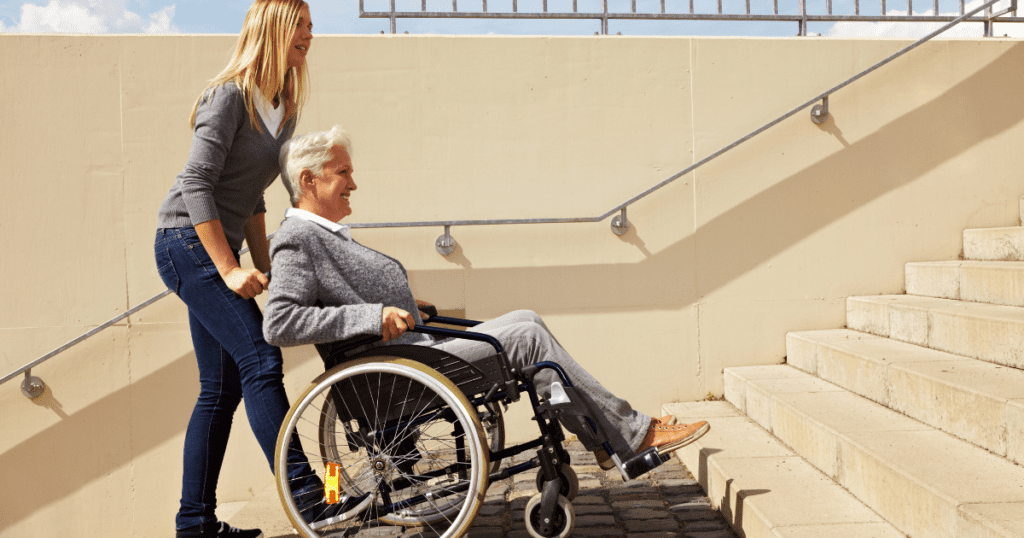In a world that’s becoming increasingly inclusive, discussions about mobility and accessibility devices, such as self-propelled wheelchairs, are more crucial than ever. These devices bestow users with enhanced independence and autonomy, significantly elevating their quality of life. Today, I will delve into a thorough discourse on How To Use a Self Propelled Wheelchair. Together we will explore various aspects, including the basic use of these wheelchairs, whether one can push a self-propelled wheelchair, and the ease of use associated with self-propelled wheelchairs. This guide aims to educate and inform, making the realm of self-propelled wheelchairs a bit less intimidating for newcomers while also offering insights that even experienced users may find beneficial.
What is a Self Propelled Wheelchair?

A self propelled wheelchair is a type of wheelchair designed to be propelled by the user. They’re distinct from transit or attendant wheelchairs, designed to be pushed by a caregiver. The defining feature of self-propelled wheelchairs is their large, often inflatable, wheels with attached hand rims. These hand rims, which are smaller circles attached to the inside of the wheel, allow users to manually move and steer the chair by pushing them.
Self-propelled wheelchairs have a rich history. The basic concept dates back to the 6th century BCE, but the modern design we recognize today began to take shape in the 1930s, thanks to the work of engineers like Harry Jennings and Herbert Everest. Their folding X-frame design revolutionized the wheelchair’s portability, leading to the versatile and dynamic wheelchairs we see today.
Modern self-propelled wheelchairs come in a wide range of models, catering to different needs and lifestyles. Lightweight sports models, for instance, are built for speed and agility, perfect for athletes or those with an active lifestyle. On the other hand, heavy-duty models are designed to be robust and durable, accommodating larger weight capacities and suitable for various terrains.
How to Use a Self Propelled Wheelchair

Using a self propelled wheelchair effectively is an art that requires practice and patience. Here are the key steps:
Transferring to the Wheelchair
Safety is paramount. Always ensure the wheelchair is on a flat, stable surface and the brakes are engaged before transferring. Use secure objects around you for support if needed. Having a caregiver or friend present during the first few attempts might be helpful until you get the hang of it.
Propelling the Wheelchair
The unique feature of self-propelled wheelchairs is their maneuverability. The user propels the chair by gripping the hand rims and pushing them forward or back. To turn, push forward on one hand rim while pulling back on the other. It may take some practice to get a smooth, straight movement, but soon it will become a natural motion.
Managing Slopes and Uneven Surfaces
These can pose a challenge even for experienced users. Going uphill requires strength and endurance. It’s recommended to lean forward and push the hand rims in short pushes. When descending, please resist the urge to grip the hand rims tightly; instead, hold them loosely to allow the chair to roll slowly while maintaining control.
Safety Precautions
Using a wheelchair safely involves more than just learning to move. It’s essential to be aware of your surroundings and to take precautions like wearing non-slip gloves for better grip and avoiding wet or icy surfaces.
Can You Push a Self Propelled Wheelchair?

While self-propelled wheelchairs are primarily designed for individual use, there may be situations when assistance is needed, such as navigating a steep incline or moving through a crowded area. In these instances, the question arises, Can You Push a Self Propelled Wheelchair?” The answer is yes; it is indeed possible. However, it’s essential to bear in mind that the primary purpose of a self-propelled wheelchair is to foster the user’s independence. Any help should be offered respectfully and only if the user consents.
When pushing a self-propelled wheelchair, position yourself behind the chair, holding the push handles firmly but without excessive force. Ensure the wheelchair’s brakes are released. Lean forward, utilizing your body weight to aid in pushing rather than depending solely on your arm strength.
Are Self Propelled Wheelchairs Easy To Use

The allure of self-propelled wheelchairs is in the independence they offer to users. They empower individuals to navigate freely, fostering a sense of self-reliance. This autonomy is often a significant factor when users describe self-propelled wheelchairs as ‘easy to use,’ answering the question, “Are Self Propelled Wheelchairs Easy To Use?
However, there can be challenges associated with using a self-propelled wheelchair. The physical exertion needed to move the wheelchair can be a hurdle for some users. It’s crucial to remember that, as with any physical activity, strength, and stamina improve with regular use. Furthermore, propelling a wheelchair can act as exercise, enhancing cardiovascular health.
Navigating certain terrains can be tricky. Rough outdoor surfaces, inclines, or confined spaces can present challenges. However, many users find that with practice, they can effectively maneuver their wheelchairs through various settings. When assistance is needed, the question arises, “Can You Push a Self-Propelled Wheelchair?” The answer is yes, but always with the user’s consent to maintain their autonomy.
Maintenance and Care of Self Propelled Wheelchairs

Regular maintenance and care of a self-propelled wheelchair can substantially extend its service life and ensure its functionality. A well-maintained wheelchair doesn’t just provide a smoother ride; it also enhances safety by minimizing the risk of unforeseen breakdowns. Here is a comprehensive guide on maintaining and caring for your self-propelled wheelchair.
Cleaning Your Wheelchair
Maintaining the cleanliness of your wheelchair isn’t just about aesthetics. Dirt and grime can build up, causing increased wear on the moving parts, leading to premature failure and reduced performance. It’s important to clean the different parts of the wheelchair appropriately:
Frame and Wheels
Wipe down the frame of the wheelchair and the wheels using a damp cloth. If the dirt is stubborn, a mild detergent mixed with warm water can help break it down. Be sure to dry the parts thoroughly after cleaning to prevent rusting. A silicone-based spray can help repel water and dirt, but be sure not to get any on the hands as this can make them slippery.
Upholstery
Regularly clean the upholstery to keep it fresh and to prevent stains from setting. Remove any debris and clean the material with a cloth and mild soapy water. Use a fabric cleaner for stubborn stains, but always test it on a small, hidden area first to ensure it won’t discolor the fabric.
Hand Rims
These are frequently touched and can accumulate dirt quickly. They should be cleaned regularly for optimal grip and control.
Regular Inspections and Adjustments

Regularly inspecting your wheelchair can help you spot issues before they become bigger problems. Pay attention to the following:
Brakes
Check the brakes regularly to ensure they engage fully and hold the wheelchair in place when applied. If they feel loose or the wheelchair slips when the brakes are applied, it may be time for an adjustment or replacement.
Bearings
These allow the wheels to turn smoothly. If you notice increased resistance when pushing the wheelchair or grinding noise, it might be a sign the bearings need lubrication or replacement.
Seat and Backrest
Inspect for any signs of wear or damage. Loose or worn-out upholstery can cause discomfort and lead to pressure sores.
Tire Pressure and Wear
Wheelchair tires need regular inspection. Check the tires for adequate pressure—too much or too little air can affect maneuverability and the smoothness of the ride. Additionally, inspect the tires for wear and tear. If the treads are worn, or the tires are damaged, they should be replaced.
Professional Servicing

Despite your best efforts at home maintenance, it’s important to have your wheelchair professionally serviced at least once a year. Professional technicians can spot potential issues that might not be evident to the untrained eye. They can check aspects like wheel alignment, brake performance, frame integrity, and other critical factors.
During a professional service they will do:
Alignment Check
The service team will inspect the wheelchair’s alignment. Misalignment can cause a wheelchair to veer to one side or affect the smoothness of the ride.
Brake Check
The technicians will test the brakes for efficiency. If necessary, they can tighten or replace the brake pads.
Lubrication
All moving parts will be adequately lubricated to ensure smooth operation. This includes the axles, the folding mechanism (if present), and the bearings.
Comprehensive Inspection
The entire wheelchair will be inspected for any damage, wear and tear, or potential problems. Any issues found will be fixed, or parts replaced as necessary.
To Wrap Things Up…

The world of self-propelled wheelchairs is fascinating, filled with history, technology, and innovation. These devices, designed to enhance personal mobility and independence, are incredibly versatile. They can be pushed when necessary but are primarily built for self-use, giving users a sense of control over their movement.
Understanding how to use self-propelled wheelchairs, their possibilities and limitations, and their ease of use is crucial for users, caregivers, and anyone interested in promoting accessibility and independence. We hope this guide has provided valuable insights and practical advice on self-propelled wheelchairs.
If you’ve found this guide helpful or enlightening, please share it with others. Awareness and understanding are key to fostering a more inclusive society. We invite you to contribute to the conversation—share your experiences, insights, or questions about self-propelled wheelchairs in the comments below. Let’s learn and grow together in promoting mobility and accessibility for all.
What does self propelled wheelchair mean?
In essence, a self-propelled wheelchair is a chair designed for the user to move independently. Although these wheelchairs may feature handles for someone else to push, their primary design focus is to allow the user to navigate the chair on their own, eliminating the need for external help.
More Wheelchair Articles Here
- Drive Medical Blue Streak Wheelchair Pro Review
- The 3 Best Self Propelled Wheelchairs For Adults
- Gel Cushions For Wheelchairs
What Next?
Looking for more information about Wheelchairs look here What To Look For When Buying A Self Propelled Wheelchair
